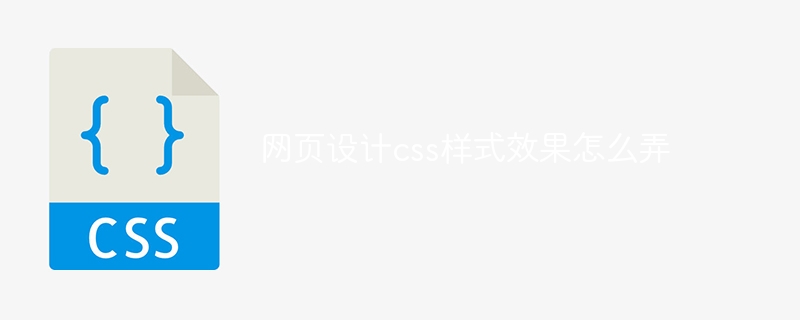How to create css style effects in web design
<p>In web design, CSS style effects are achieved in the following ways: adding style sheets, linking external CSS files or defining inline styles; using selectors to match HTML elements; setting style attributes that contain attribute values, such as color , font size, and background color; apply advanced CSS effects such as transitions, animations, and transformations.<p>
 <p>Achievement of CSS style effects in web design
<p>Introduction:
<p>Achievement of CSS style effects in web design
<p>Introduction:CSS (Cascading Style Sheets) is a language for defining style and layout in web design. By using CSS, you can easily change the appearance and behavior of web page elements. <p>How to achieve CSS style effects:
-
Add a style sheet:
In HTML documents, use< ;link>tag to link to an external CSS file, or use the<style>tag to define inline styles within the document header. -
Define selector:
The selector is used to match HTML elements, such as#id,.classor element name (such asp). -
Set attribute value:
The selector is followed by curly brackets, which contains the style attribute to be applied to the matched element, such ascolor,font- sizeandbackground-color.
<style>
p {
color: red;
font-size: 20px;
}
</style><p> elements on the page red with a font size of 20 pixels Size display.
<p>Advanced CSS Effects:In addition to basic styles, CSS also allows the creation of more advanced effects, such as:
- Transitions:When the attribute value of the element gradually changes over time.
- Animation: Create dynamic, visually appealing effects.
- Transformation: Change the shape or size of an element.
- Filters: Apply visual effects such as blur or hue shift.
- Use an external style sheet: This helps keep your HTML document clean and Ease of maintenance.
- Use semantic HTML: Apply CSS to HTML semantic elements rather than specific tags.
- Avoid too many inline styles: Inline styles can make code difficult to maintain.
- Use a CSS preprocessing language: Such as Sass or Less, which can simplify CSS code and add additional functionality.
The above is the detailed content of How to create css style effects in web design. For more information, please follow other related articles on the PHP Chinese website!

Hot AI Tools

Undresser.AI Undress
AI-powered app for creating realistic nude photos

AI Clothes Remover
Online AI tool for removing clothes from photos.

Undress AI Tool
Undress images for free

Clothoff.io
AI clothes remover

Video Face Swap
Swap faces in any video effortlessly with our completely free AI face swap tool!

Hot Article

Hot Tools

Notepad++7.3.1
Easy-to-use and free code editor

SublimeText3 Chinese version
Chinese version, very easy to use

Zend Studio 13.0.1
Powerful PHP integrated development environment

Dreamweaver CS6
Visual web development tools

SublimeText3 Mac version
God-level code editing software (SublimeText3)

Hot Topics
 1392
1392
 52
52
 How to use bootstrap in vue
Apr 07, 2025 pm 11:33 PM
How to use bootstrap in vue
Apr 07, 2025 pm 11:33 PM
Using Bootstrap in Vue.js is divided into five steps: Install Bootstrap. Import Bootstrap in main.js. Use the Bootstrap component directly in the template. Optional: Custom style. Optional: Use plug-ins.
 The Roles of HTML, CSS, and JavaScript: Core Responsibilities
Apr 08, 2025 pm 07:05 PM
The Roles of HTML, CSS, and JavaScript: Core Responsibilities
Apr 08, 2025 pm 07:05 PM
HTML defines the web structure, CSS is responsible for style and layout, and JavaScript gives dynamic interaction. The three perform their duties in web development and jointly build a colorful website.
 How to write split lines on bootstrap
Apr 07, 2025 pm 03:12 PM
How to write split lines on bootstrap
Apr 07, 2025 pm 03:12 PM
There are two ways to create a Bootstrap split line: using the tag, which creates a horizontal split line. Use the CSS border property to create custom style split lines.
 Understanding HTML, CSS, and JavaScript: A Beginner's Guide
Apr 12, 2025 am 12:02 AM
Understanding HTML, CSS, and JavaScript: A Beginner's Guide
Apr 12, 2025 am 12:02 AM
WebdevelopmentreliesonHTML,CSS,andJavaScript:1)HTMLstructurescontent,2)CSSstylesit,and3)JavaScriptaddsinteractivity,formingthebasisofmodernwebexperiences.
 How to use bootstrap button
Apr 07, 2025 pm 03:09 PM
How to use bootstrap button
Apr 07, 2025 pm 03:09 PM
How to use the Bootstrap button? Introduce Bootstrap CSS to create button elements and add Bootstrap button class to add button text
 How to resize bootstrap
Apr 07, 2025 pm 03:18 PM
How to resize bootstrap
Apr 07, 2025 pm 03:18 PM
To adjust the size of elements in Bootstrap, you can use the dimension class, which includes: adjusting width: .col-, .w-, .mw-adjust height: .h-, .min-h-, .max-h-
 How to set up the framework for bootstrap
Apr 07, 2025 pm 03:27 PM
How to set up the framework for bootstrap
Apr 07, 2025 pm 03:27 PM
To set up the Bootstrap framework, you need to follow these steps: 1. Reference the Bootstrap file via CDN; 2. Download and host the file on your own server; 3. Include the Bootstrap file in HTML; 4. Compile Sass/Less as needed; 5. Import a custom file (optional). Once setup is complete, you can use Bootstrap's grid systems, components, and styles to create responsive websites and applications.
 How to insert pictures on bootstrap
Apr 07, 2025 pm 03:30 PM
How to insert pictures on bootstrap
Apr 07, 2025 pm 03:30 PM
There are several ways to insert images in Bootstrap: insert images directly, using the HTML img tag. With the Bootstrap image component, you can provide responsive images and more styles. Set the image size, use the img-fluid class to make the image adaptable. Set the border, using the img-bordered class. Set the rounded corners and use the img-rounded class. Set the shadow, use the shadow class. Resize and position the image, using CSS style. Using the background image, use the background-image CSS property.




